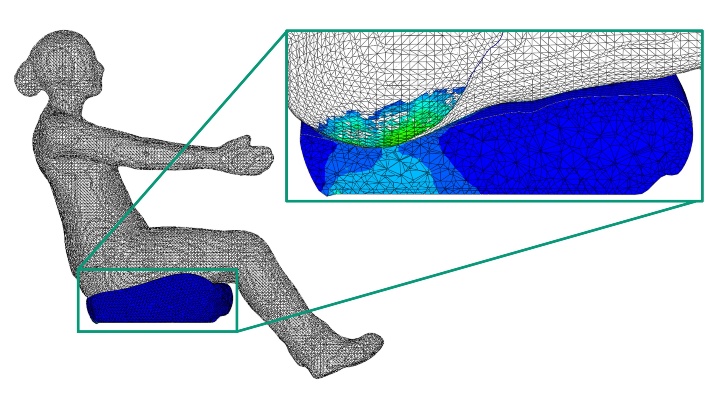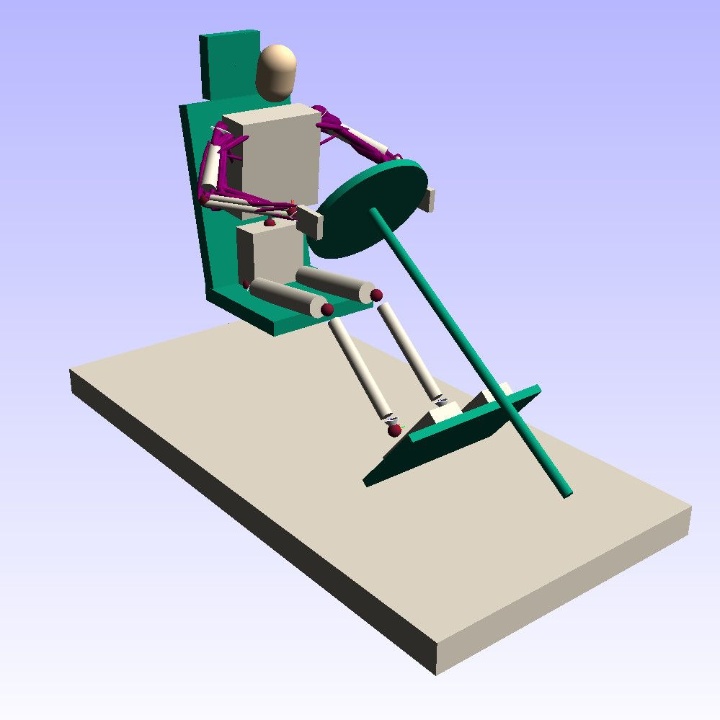Relax, work, watch movies: once cars can drive by themselves, drivers can put their commute into work to good use. To make sure that ergonomics and safety don’t get overlooked in the process, researchers at the University of Stuttgart, the Fraunhofer Institute for Industrial Mathematics (ITWM) as well as the company fleXstructures (both based in Kaiserslautern) have joined forces to develop a muscle-activated human model which makes it possible to dynamically simulate how driving maneuvers have an impact on the interactions between human soft tissue and the car seat. The German Research Foundation (DFG) is funding the project as part of the new line of trilateral transfer projects.
The Baden-Württemberg Minister for Science, Research and the Arts Theresia Bauer congratulates the project partners: “I’m very happy that the University of Stuttgart’s project “EMMA4Drive – A Dynamic Human Model for Autonomous Driving” is one of the six projects being supported by the DFG and the Fraunhofer Society. This is further proof of the transfer strength of the University of Stuttgart also with regard to the Stuttgart Way – forward-looking research is being directly applied to a real-life situation and strengthening the cooperation between science and business, which we are also intensively promoting and supporting at state level.”
Previously, human models have either been used in crash simulations to estimate the risk of injury or in ergonomic analyses. When conducting crash analyses, detailed FE models are used to make calculations at intervals of a few milliseconds, which are very intensive in terms of the computing time required. This makes them unsuitable for simulating dynamic driving maneuvers, because in this case much longer processes need to be simulated. Human models for the purpose of ergonomics analysis on the other hand are based on simplified movement mechanisms, and have previously only been suitable for quasi-static investigations. Realistic stances and movements when carrying out new activities can only be simulated using these models with considerable effort.
Boosting confidence in the safety of technology
New (software) tools are required for those who want to understand customer expectations regarding (partly) autonomous driving, explore the potential uses of the car, as well as boost people’s confidence in the technology and prove that it is safe. Against this background, the network led by Asst. Prof. Jörg Fehr, Researcher in the Cluster of Excellence "Data-Integrated Simulation Science” (EXC 2075, SimTech) and Deputy Leader of the Institute of Engineering and Computational Mechanics (ITM) at the University of Stuttgart, intends to create the software prototype EMMA4Drive, which as a digital image of the occupant can analyze and evaluate the safety and ergonomics in equal measure during driving maneuvers under dynamic loads.
Extensive preparatory work
Scientific findings from projects carried out by the Cluster of Excellence 310, the predecessor of the EXC 2075, should also be transferred to the muscle-activated multi-body human model EMMA (Ergo-dynamic Moving Manikin) and be developed further for use in the (partly) autonomous vehicles of the next generation. The ITWM, led by project leader Joachim Linn, contributes specialist knowledge on multi-body human modeling and movement optimization. Thanks to its optimization algorithm, the prototype human model EMMA which has been developed can automatically calculate new stances and movement sequences with the associated muscle activity, and provides a very efficient model for a stable dynamic simulation with large time steps. The company fleXstructures was previously responsible for the development, maintenance and sales of the IPS software family, including the digital human model IPS IMMA.
Expert Contact:
Asst. Prof. Jörg Fehr, University of Stuttgart, Institute of Engineering and Computational Mechanics and Clusters of Excellence and SimTech, Tel: +49 (0)711/685 66392, e-mail




